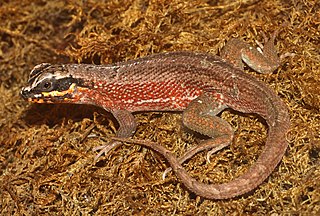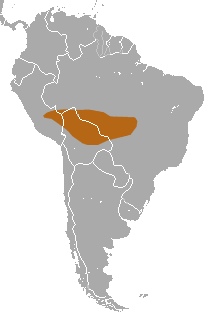
Amphisbaenia is a group of usually legless squamates, comprising over 200 extant species. Amphisbaenians are characterized by their long bodies, the reduction or loss of the limbs, and rudimentary eyes. As many species have a pink body and scales arranged in rings, they have a superficial resemblance to earthworms. While the genus Bipes retains forelimbs, all other genera are limbless. Although superficially similar to other limbless vertebrates including the snakes, legless lizards, and blind lizards, recent phylogenetic studies suggest that they are most closely related to wall lizards of the family Lacertidae. Amphisbaenians are widely distributed, occurring in North America, Europe, Africa, South America, Western Asia and the Caribbean. Most species are less than 6 inches (15 cm) long.

Iguania is an infraorder of squamate reptiles that includes iguanas, chameleons, agamids, and New World lizards like anoles and phrynosomatids. Using morphological features as a guide to evolutionary relationships, the Iguania are believed to form the sister group to the remainder of the Squamata, which comprise nearly 11,000 named species, roughly 2000 of which are iguanians. However, molecular information has placed Iguania well within the Squamata as sister taxa to the Anguimorpha and closely related to snakes. The order has been under debate and revisions after being classified by Charles Lewis Camp in 1923 due to difficulties finding adequate synapomorphic morphological characteristics. Most Iguanias are arboreal but there are several terrestrial groups. They usually have primitive fleshy, non-prehensile tongues, although the tongue is highly modified in chameleons. The group has a fossil record that extends back to the Early Jurassic. Today they are scattered occurring in Madagascar, the Fiji and Friendly Islands and Western Hemisphere.
Agathidium bushi is a species of round fungus beetle in the family Leiodidae. It is found in North America.

Trilophosaurs are lizard-like Triassic allokotosaur reptiles related to the archosaurs. The best known genus is Trilophosaurus, a herbivore up to 2.5 metres long. It had a short, unusually heavily built skull, equipped with massive, broad flattened cheek teeth with sharp shearing surfaces for cutting up tough plant material. Teeth are absent from the premaxilla and front of the lower jaw, which in life were probably equipped with a horny beak.
Charles Lewis Camp was a palaeontologist and zoologist, working from the University of California, Berkeley. He took part in excavations at the 'Placerias Quarry', in 1930 and the forty Shonisaurus skeleton discoveries of the 1960s, in what is now the Berlin-Ichthyosaur State Park. Camp served as the third director of the University of California Museum of Paleontology from 1930 to 1949, and coincidentally as chair of the UC Berkeley Paleontology Department between 1939 and 1949. Camp named a number of species of marine reptiles such as Shonisaurus and Plotosaurus, as well as the dinosaur Segisaurus.
The long-tailed armored tree-rat, is a spiny rat species from South America. It is found in Brazil, with a population in Ecuador which is referable either to this species or to Makalata didelphoides. Initially considered a large form of the latter species, it actually represents a distinct species as supported by morphological and molecular characters.
Agathidium vaderi is a species of round fungus beetle in the family Leiodidae. It is found in North America. The beetle was named after the fictional character Darth Vader by Cornell University entomologists due to its shiny helmetlike head that resembles that of the Star Wars villain.

Ingerophrynus quadriporcatus is a species of toad in the family Bufonidae. Its common names are long-glanded toad, four-ridged toad and greater Malacca toad. It is found in Peninsular Malaysia, Singapore, Borneo, Sumatra, and the Natuna Islands. Its natural habitats are swamp forests, but it has also been found on rubber plantations. It breeds in standing water.
Allobates undulatus is a species of frog in the family Aromobatidae. It is endemic to Venezuela where it is only known from its type locality, Cerro Yutajé, in the Amazonas state. The specific name undulatus refers to the characteristic wavy-edged dorsal marking of this species.

The checkerboard worm lizard is a species of amphisbaenian in the family Trogonophidae. The species is monotypic within the genus Trogonophis, and is endemic to North Africa. Its natural habitats are temperate forests, Mediterranean-type shrubby vegetation, temperate grassland, sandy shores, arable land, and pastureland. It is threatened by habitat loss.
Agamodon is a small genus of worm lizards in the family Trogonophidae. They are found in the Horn of Africa and in the southern part of the Arabian peninsula. The genus contains the following three species:

Bishop's slender opossum is a small, arboreal marsupial opossum native to Brazil, Peru, and Bolivia. It somewhat resembles a placental rat or shrew.
Aiolosaurus is an extinct genus of monitor lizard from the Late Cretaceous of Mongolia. The type and only species, Aiolosaurus oriens, was named in 2000 from Ukhaa Tolgod, a rich fossil site in the Campanian-age Djadochta Formation.
Cherminotus is an extinct genus of monitor lizard from the Late Cretaceous of Mongolia. The type and only species, Cherminotus longifrons, was named in 1984.
Priscagamidae is an extinct family of iguanian lizards known from the Late Cretaceous of Mongolia and China and the Eocene of India, spanning a range from 83.6 to 48.6 million years ago. Probably the earliest priscagamids on indeterminate genera were found in Aptian-Albian sediments in "Hobur", Mongolia. It includes the genera Heterodontagama, Mimeosaurus, Phrynosomimus, Priscagama, and possibly Pleurodontagama. The first fossils of priscagamids were found in the Djadochta and Khermeen Tsav formations of Mongolia. More recently they have been found in the Cambay Formation in India, leading to the naming of Heterodontagama in 2013. Priscagamidae was originally described as a subfamily of Agamidae called Priscagaminae in 1984, but it was reclassified as a distinct family in 1989. Most phylogenetic analyses still find a close relationship between Priscagamidae and Agamidae, although a 2015 study found it to be basal to all other iguanian clades, warranting its removal from Iguania and placement in a larger clade called Iguanomorpha.
Priscagama is an extinct genus of iguanian lizard from the Late Cretaceous of Mongolia and China. It belongs to an extinct family of iguanians called Priscagamidae. Several incomplete skulls have been found in the Barun Goyot and Djadochta formations, and were originally referred to the genus Mimeosaurus; the type species Priscagama gobiensis was named in 1984 when it was recognized that these skulls belonged to a distinct species. Priscagama differs from most other priscagamids in having a more elongate, lightly built skull. It is very similar in appearance to another priscagamid called Pleurodontagama, as the two can only be distinguished by the shape of their teeth.
Agathidium difforme is a species of round fungus beetle in the family Leiodidae. It is found in North America.
Cynisca is a genus in the family Amphisbaenidae, commonly known as worm lizards. 20 species are placed in this genus.
Monopeltis is a genus of amphisbaenians in the family Amphisbaenidae. Species in the genus are commonly known as worm lizards, even though they are not lizards. The genus is endemic to southern Africa. 19 species are placed in this genus.
The flat worm lizard is a species of reptile in the family Trogonophidae. It is found in Somalia.





